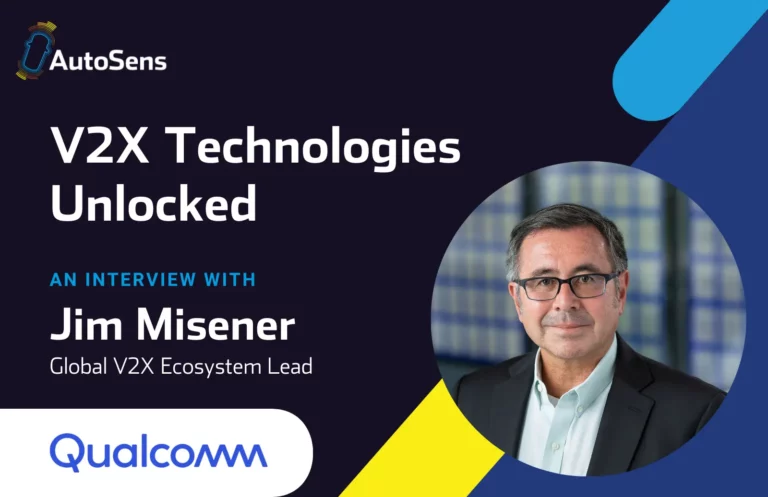Our Managing Director here at AutoSens, Rob Stead is looking forward to hearing from Shane Elwart at AutoSensONLINE this month (23 November). Shane led global developments in ADAS and AV at two of the world’s largest OEM’s. He is now working on his own driverless transportation and will be sharing details from his previous work, and his views on reality vs the executive expectations, and the symplexity of ADAS and AVs. The ADAS and AV problem creates great complexities that through experience, frustration and blindsided expectations can bring simplicity, elegance and synergies that could lead to the ubiquity of autonomous vehicles.
This virtual plenary session at 1.30pm (GMT) on 23 November will present a background on some complex ADAS and AV situations that have led to simplifications and synergies, symplexities if you will. As we know development often brings about situations that call for a reality check and often when these reality checks cross well meaning people from the developer level to the executive, it can bring about some frustrations, but can lead to spectacular results. The presentation will cover a few key examples past to current and an approach that can change the paradigm from endless complexities to symplexity.
Robert took the opportunity to catch up with Shane and ask him a few hard-hitting questions about what he has been up to, how his ideas can help shape the industry and his outlook for the future.
You have a pretty impressive career behind you, what do you consider the highlights?
There are many memorable highlights from my career, like 30% Fuel Economy, 30 Day AV by-wire, No-cost Level 2 and ground up Level 4 full stack in < 10 months and more. One of my favorite achievements was the development of anti-jackknife control for Pro-trailer Backup Assist, the associated Technical Achievement Award, and the Henry Ford Technology award. Out of all of it, I have been named inventor on 100 US issued patents in powertrain controls, aftertreatment controls, fuel cells, driver assistance, mapping, localization, autonomous vehicles and more.
What have you been building, with whom, and why did you set such a deadline?
Purpose built driverless shuttle that is low cost and for everyone, with my family – including my wife, 5 children and 5 brothers, the deadline was set as part of an unplanned set of events (COVID shut down the ADS development at the company I was working for). More than this, however, we intended to start a company and wanted to make an entrance and a splash as opposed to just drawing some pictures on a piece of paper and talking make believe. I believe in making things real and so we decided to design, build, and test our initial prototype in 100 days, and we succeeded in just over 100 days demonstrating driving in a simplified ODD with no driver or passengers present. As you can imagine, to pull this off, building a vehicle from the ground up, let alone safely, a lot of thought, planning and testing was required especially under such tight timing and limited resources, and it shows that we can achieve and do far more in the EV and AV space.
The vehicle is low speed, low cost, low complexity. Why does that route represent an opportunity to you?
You cannot produce a 4-12 passenger vehicle that costs half a million dollars and compete in the space of rideshare (Uber, Lyft, etc.), transit (bus, tram, etc.), ….
There are some many historical examples of where we find ourselves today in the AV industry. Everyone is talking about what AV could do, many are planning for the future, and few can actually do anything about it at all, because the cost in general starts at about $250,000 just for a by-wire vehicle with a pile of sensors and compute that has no ADS software. This reminds me of the early days of the auto industry and the early days of the computer industry, everyone was interested in getting access and developing businesses and technologies using the early automobile or the early computer, but they were so expensive and required full time mechanics or technicians to maintain them. It is time to change that, if you develop a 4 to 12 passenger vehicle that cost say a half million dollars and your goal is to pick up customers and make the customers pay for rides to cover the cost of the vehicle and all the ongoing development, then you may need to charge about $50 or more per ride in some cases to break even. Really the overall system needs to be comparable or preferably less than the cost of a standard vehicle and the cost to operate and maintain that vehicle at profit. Currently, Uber, Lyft, and others see about $10 per ride and as low as $1 per ride for some subsidized transit providers. That said, to compete at least with Uber, Lyft and the like it needs to be at least 5 times less expensive and more realistically, 10 times less expensive, otherwise, we might just continue to rely on human drivers. Most developers are targeting a 10% reduction in the cost of their platform, not a 10 times reduction in the cost of their platform. Furthermore, our urban communities make up a huge portion of driving miles in the US and a large majority of rideshare service areas, this leads to a major opportunity in the low speed. Additionally, reducing speed at and below 25 MPH results in a 10-time reduction in probability of fatality in the event that a vehicle collides with a pedestrian. Low complexity, there are so many reasons, once you reduce the complexity, you reduce the cost, when you reduce the cost you increase the opportunity, reduce risk, improve the intended function, and so much more.
What’s different between your vehicle and something like EasyMile, for example?
Some key differentiating factors from vehicles like EasyMile and others is that it is designed to be a LSV and meet FMVSS 500, EasyMile and others offer platforms in the $250,000 to $500,000 range, weigh as much as 6,000lbs or more and do not and cannot meet and FMVSS standard. This means that all development will be through exemption and cannot lead to full series production.
How big is the market for low speed, controlled environment vehicles? How is it evolving?
The target market should include low speed passenger and package delivery and is estimated to be $102 Billion annually in the US ($265 Billion by 2026), $324 Billion annually globally ($788 Billion by 2026). We are getting more and more distracted, and few young people want to drive, in addition to this, we are purchasing more items online and having them delivered to our homes, businesses and storefronts. This will continue to increase the need for reduced emissions, road load impact, need for drivers for the movement of goods and people.
What can we learn from your project and apply to mass production consumer vehicles, or other AV segments?
Many of the design items in our vehicles are legacy design and have not been rethought in the last 50 to 100 years. We are good at repurposing vehicles, but we have much to learn about our current environment and our society’s mobility needs. I am amazed that there is not one series production vehicle still in production in the traditional auto industry that is for sale that is designed for people with disabilities. There are millions of Americans with disabilities that cannot use production vehicles as equipped by the manufacturer and therefore must pay as much as $70k to have vehicle upfit to support a wheelchair. So many homes and businesses are accessible, but to get between home and business, there are no cost-efficient solutions that exist after more than 100 years of mass-producing automobiles. More than this, often we never create the things that we could because we never even take the first step or challenge ourselves to beat the status quo.
What is your long term vision?
In the near term we are looking to get 25 of our platforms to universities and developers in the State of Michigan and in the next 5 years we want to get 1935 of our platforms in 341 universities and 229 businesses across the US. This will give them 10 times the access to AV platforms compared with anywhere in the world. Within 5 years our goal is to produce a fully functional cost-effective driverless service and begin scaling in cities in the US and throughout the world. Following this we would be looking to produce a full speed driverless platform and service. We want to produce high tech quality jobs for the people of our state and country. More than this we want to keep our state’s title as the Motor Capital of the World, keep our country’s competitive edge and more importantly, revive the American dream throughout this country and around the world and to bring hope to the world.
AutoSensONLINE. Streaming live online on Tuesday 23 November 2021
AutoSensONLINE is being delivered virtually to wrap up 2021. Bringing together key topics in this disruptive time for the automotive industry. Addressing technical challenges across ADAS and AV development is an overarching theme of AutoSensONLNE and participants will takeaway insights from both presentations and panel discussions to help them deal with their own engineering challenges they might encounter.








